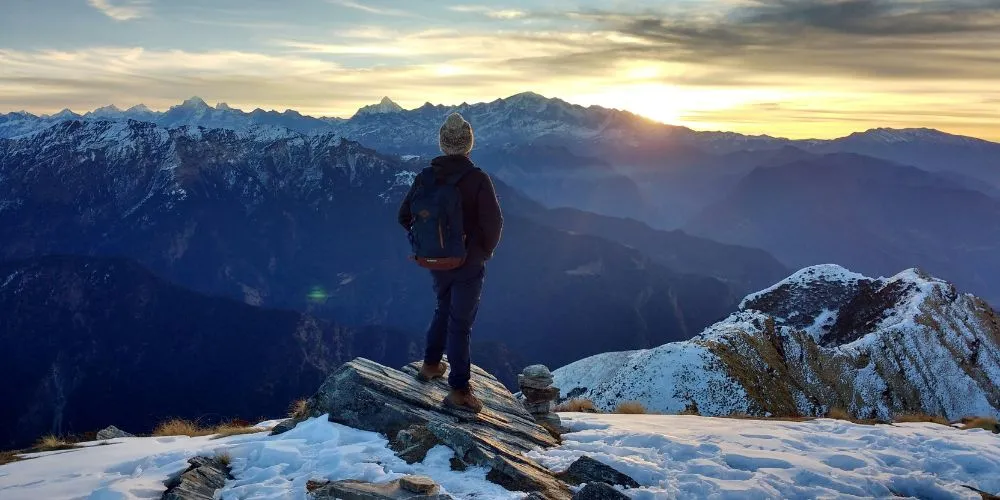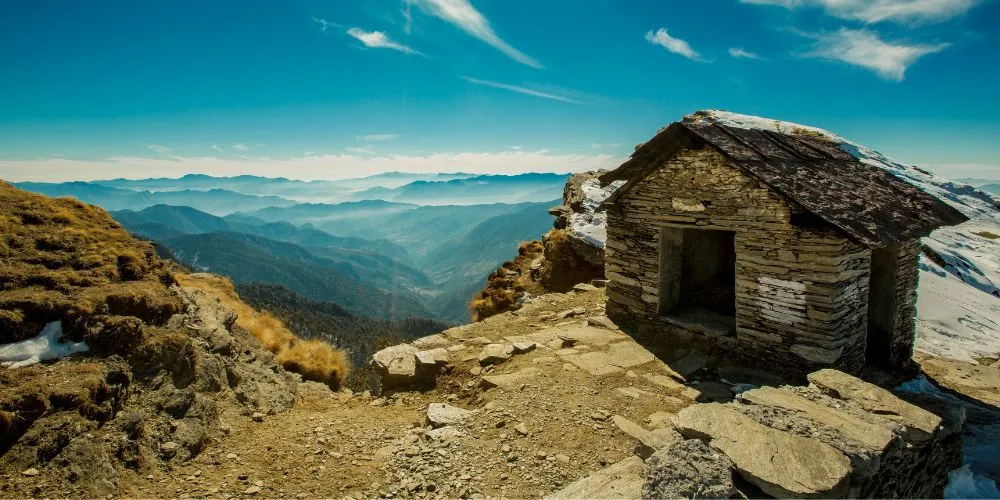Situated in Uttarakhand’s Rudraprayag district, Chopta is a serene and pristine high-altitude hamlet that often feels like a landscape lifted from a dream. Known as the “Mini Switzerland of India,” Chopta Valley mesmerises with its alpine pastures, deep forests, and panoramic views of the greatest Himalayan peaks. Highlighted by the iconic Chopta Chandrashila Trek and the sacred Chopta Tungnath temple, this place has so much to offer to travellers of all age groups and from diverse geographies.
The Soul of Chopta: Treks and Temples

Chandrashila Peak
- Chopta Chandrashila Trek: Undoubtedly, the star attraction of Chopta is the Chopta Chandrashila Trek. This moderate yet rewarding trail takes you through dense forests of rhododendrons and deodars, opening out onto meadows so sublime, you’ll want to slow your steps. Starting from Chopta, the well-paved trekking path ascends over about 5.5 kilometers to Chandrashila Peak. The trek passes the world-famous Tungnath Temple, then climbs higher to Chandrashila, which soars at roughly 4,000 meters.
From the summit, the view is breathtaking; 360-degree Himalayan panoramas including Nanda Devi, Trishul, Chaukhamba, and Kedar peak ranges. Legends claim Lord Ram meditated here afier defeating Ravana, and the name Chandrashila (“Moon Rock”) itself evokes a sense of cosmic serenity. The trek is accessible nearly all year, but spring (April-May) and autumn (September-November) are most popular for pleasant weather and clear skies which makes it easier to view the entirety of the landscape. - Chopta Valley: Nature’s Untouched Canvas: Stepping into Chopta Valley is like entering a living postcard. Meadows (locally called “bugyals”) roll beneath mighty peaks; in spring, rhododendrons add the perfect dash of colour to the slopes. Birdwatchers may spot the Himalayan Monal, while lucky trekkers could spot musk deer amid the forests of the Kedarnath Wildlife Sanctuary. Other must-visit jewels include the secluded lakes of Deoriatal, Rohini Bugyal for picturesque camping, and the Madhyamaheshwar Temple for those venturing farther afield.
- Chopta Tungnath: No trip to Chopta is complete without a visit to the mystical Chopta Tungnath. This is the highest Shiva temple in the world, perched at 3,680 meters and part of the revered Panch Kedar pilgrimage circuit. Pilgrims and trekkers alike are drawn to its ancient stone architecture, spiritual energy, and the feeling of being so close to the gods. The 3.5 km trek up to the temple is relatively gentle, and along the way, you’ll witness carpets of wildflowers or, in winter, an otherworldly snowscape.

Tungnath Temple
Travel and How to Reach
Chopta is best accessed via Rishikesh or Haridwar, with the nearest major rail links. From Rishikesh, a scenic 185 km road journey (about 7-8 hours) brings you into the Himalayas via towns like Devprayag, Rudraprayag, and Ukhimath. Taxis and buses are available, but self-drive offers flexibility for frequent stops and photo ops. Plan buffer time for mountain roads and sudden weather changes.
Places to Stay in Chopta
Accommodation in Chopta blends comfort with authenticity. The area now offers everything from basic lodges and friendly guesthouses to cozy campsites and luxury resorts. Many trekkers prefer to camp beneath the stars, while families or couples can choose from rustic yet charming wooden cabins. Book your stay in advance during spring and autumn, when the meadows are busiest with trekkers.

Preparation and Essential Gear for The Chopta Chandrashila Trek
This trek is suitable for both beginners and seasoned trekkers but don’t underestimate Himalayan weather:
- Clothing: Layer up! Pack quick-dry, sweat-wicking base layers, fleece, a windproof jacket, and thermal inners for cold nights. In winter, add gloves, caps, and extra socks.
- Shoes: Good-quality trekking boots with ankle support are a must, especially if you encounter snow or rain.
- Gear: Trekking poles, a sturdy backpack with rain cover, reusable water bottle, and a headlamp are non-negotiable.
- Other Essentials: Sunscreen, sunglasses (the glare at altitude can be intense), basic first aid, dry snacks, hand sanitizer, and personal medicine.
- Permits: While Chopta does not require special permits for Indian travellers, always carry an ID. If you plan to camp in wildlife areas, check rules at the local forest office.
Attractions Beyond the Trek
- Deoriatal: An easy trek from Sari village to this pristine lake provides mirror-like Himalayan views.
- Rohini Bugyal: Meadows for camping, stargazing, and immersion in Himalayan silence.
- Local Villages: Experience Garhwali culture in villages like Sari and Duggalbitta, famous for warm hospitality and home-cooked meals.
Important Tips for Your Trip
- The best time to visit Chopta is April–June and September–November. Winter brings magical snow but harsher weather conditions.
- Network coverage is spotty; let family know your plans and soak up digital detox.
- Respect the ecosystem: leave no trace, avoid plastics, and keep noise down.
- Bring cash, as ATMs are few and unreliable.
Conclusion
Chopta is much more than a trekking base; it’s an invitation to connect with untouched nature, breathe unspoiled mountain air, and experience the Himalayas in their most genuine spirit. Whether you’re chasing the legendary Chopta Chandrashila Trek, meditating at Chopta Tungnath, or simply wandering Chopta Valley’s wild meadows, this magical corner of Uttarakhand will echo in your soul long after you descend.
By: Anushka Singhal
